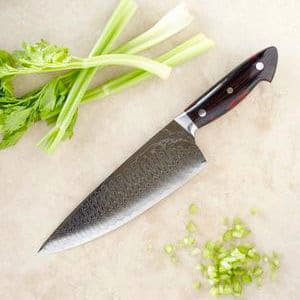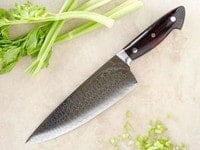
Check out my new kitchen knife. Isn’t he beautiful? I named him Mordechai. Yes, I like to name my kitchen tools. Actually, I like to name all kinds of things. Objects have personalities to me—especially objects that I use frequently. I use my chef’s knife everyday, so I figured this beauty deserved a name. Mordechai is the unsung hero of the Purim story… he refused to bow down to Haman, even though it meant risking his own life. Esther usually gets all the glory around Purim, but Mordechai played a big part in bringing justice to Haman for the Jewish people. This knife is the unsung hero in my kitchen arsenal, so I named him Mordechai. And today, I’m singing his praises!
It took me a long time to find Mordechai. When I purchase a kitchen tool, I do a lot of research to make sure that I’m getting a great product. I cook a lot, so quality and durability are very important to me. When it comes to something important like a chef’s knife, I don’t mind spending extra money. I want to invest in something that will last me several years, rather than replace a cheap product annually. Those of you who cook a lot know how important a strong, sharp knife is… it can take a lot of stress out of your prep work.
I actually started my search for the perfect knife a few months ago. I was tired of slicing and dicing with my old set of bargain basement knives; they made me dread kitchen prep, especially during Israeli Salad Week. I began researching on Google, reading articles and reviews all over the web. I emailed my friend Itamar Yeshurun, a professional Mediterranean chef and caterer. I also spent an hour talking with Brandon, a knife expert at Sur La Table Los Angeles.
And now, I’m going to sum up all of that lovely research for you… because that’s how much I love you! That way, when you start searching for your perfect chef’s knife, you’ll have an easier time than I did. As Chef Itamar reminded me:
“A knife is a very personal thing. If you buy the right one for you, it will be your cooking partner for dozens of years and could possibly even become an heirloom.”
I wanted an heirloom knife, and I believe I found one! Here are some things to keep in mind while you’re searching:
You don’t need to buy a big knife block set. When I originally set out to purchase a knife, I was thinking I’d get a block full of knives. I previously owned a bargain block set, and it was great having a few different knife styles to choose from. But it doesn’t make sense to buy a whole block of expensive knives, when you probably only use four or five of them with any frequency. Investing in a few quality knives will ultimately be a lot more useful than a block full of knives that you rarely use.
I can just hear some of you kvetching now… “But I want my knives to match!” I felt that way too, at first. But different knife brands are suited to different purposes. For me, it made sense to get a Japanese-style knife as my main chef’s knife (aka Mordechai). Japanese knives are lighter steel, sharper, and better for vegetable prep. I eat a lot of vegetarian food, so most of my prep work is with veggies and herbs. On the other hand, a German-style knife is better for heavy-duty slicing—cutting through meat, boning, etc. I’ll be getting a Wusthof for those kinds of dishes. Over the next few weeks, I’m going to add to my collection till it’s complete with the knives that are best for me.
Instead of buying a block of matching knives, I recommend you choose the knives that feel right for specific tasks. Then get a block to store them! Or if you really want to pretend you’re a Food Network star, install a magnetic strip on your wall—it’s sterile, keeps your knives in easy reach, and looks pretty hard-core too. 😉
Figure out which knives you use the most. The average home cook doesn’t need all the knives that come in a large knife block. For me, this is the ultimate knife/tool collection (in order of importance):
Chef’s knife: Your go-to utility knife for a variety of cutting purposes. Most are between 7 and 8 inches long. If I could only have one knife in my kitchen, it would be my chef’s knife. Some cooks have two different chef’s knives… a lighter Japanese-style for vegetable and fruit prep, and a German-style for more heavy-duty prep work (like slicing through butternut squash and watermelons).
Paring knife: A tiny version of the chef’s knife. Made for peeling fruits and veggies; great for delicate cuts and precision work.
Santoku knife: A wide, light blade with a flat bottom; their unique shape makes them especially useful for dicing. I use my Santoku for mincing herbs and garlic.
Kitchen shears: Okay, I know it’s not technically a knife. But a good set of kitchen shears is essential in the kitchen. I use mine daily; they’re especially helpful with poultry prep. Pick a sharp, heavy-duty set and it should last you for a long time. Come-apart shears make cleaning easier.
Boning knife: A super sharp knife with a narrow, slightly curved blade and pointed tip. Used for removing bones from different types of meat.
Serrated bread knife: Used for cutting bread. A good bread knife is important, but you don’t need to break the bank for it. Serrated knives are tough to sharpen, so it’s better to buy a less expensive brand (like Forschner/Swiss Army) and just replace it when it gets dull.
Small serrated knife: I use my small serrated knife for cutting beets and carrots; it gives a pretty look to salads. Again, no need to break the bank, since it’s very difficult to sharpen these little guys. I use a Kuhn Rikon, which set me back $12. If it ever gets dull, I’ll buy a new one.
Filet knife: Used for filleting fish; thin and delicate blade.
Honing/sharpening steel: A honing steel is essential for keeping your knife sharp and functional for years to come. You should check with your chef’s knife manufacturer to see if it needs a special kind of steel. Most steels are interchangeable, but some knives (like Globals) need a special type of honing steel.
That’s my ultimate collection. Your collection might be different. There are so many types of knives, suited to all kinds of purposes. These just happen to be the knives that are most useful to me in my Jewish cooking. If in the future I find the need for a bird’s beak knife, a deveiner, or a meat cleaver, well… I’ll cross that bridge when I come to it. 🙂
Test drive your knife. This is the most important step you can take when choosing the right knife. There are a few places to test drive quality kitchen knives… Sur La Table, Williams Sonoma, or any professional cutlery shop. If you live in the LA area, I suggest you go to Sur La Table at The Grove and talk to Brandon… he really knows his knives! Before you test drive or buy any expensive knives, take a Knife Skills Class at your local cooking school. Even if you’ve been slicing, chopping, and paring for years, it never hurts to brush up on your knife skills. You wouldn’t drive a car without taking few lessons, right? You need to know how to hold and use a knife properly before you can test drive one!
Learn how to hone your knives. I know it’s tempting to jump right in and use that sharpening steel—the process has a kind of samurai mystique to it. But you can do a lot of damage to your chef’s knife if don’t use the steel properly. Check out this video to learn more about honing. As the video notes, the honing/sharpening steel doesn’t actually sharpen the knife. Over time, the pointed V at the edge of the knife blade falls out of alignment. A few passes with the honing steel helps keep the edge aligned, which makes cutting easier. You should hone your knife on a regular basis… I hone mine once every few days. If you hone your knife regularly, it should only need to be professionally sharpened annually… unless you’re a chef working in a busy restaurant kitchen.
One thing to keep in mind: different blades may have different sharpening angles. While this video recommends sharpening at a 20-degree angle, some blades may require a different honing angle. Check with your manufacturer to make sure you’re honing your blade properly.
Get a good cutting board. Why spend all that money on a fabulous chef’s knife, only to ruin it with a sub-par cutting board? Bamboo cutting boards are too hard (can dull your knife), and the grooves in plastic boards can also be hard on your blade. Choose a maple or pine wood block, and regularly condition it with mineral oil. If you want a lighter, more portable board that can be cleaned in the dishwasher, try Epicurean wooden boards. They’re sanitary and easy on your knife blade. I use them, they’re great. I also plan on purchasing a Boos block at some point.
Tomorrow I’ll give you an overview of the major cutlery brands, so you can start planning your own ultimate kitchen knife collection!



Thanks for pointing out that you can search online as well as through articles to find a great kitchen knife for you. You also mention that a choosing a kitchen knife is a personal thing and could possibly become an heirloom. I think it’s a good idea to also properly maintain your knives since you actually have a better chance of slipping and cutting yourself if your knife is not properly maintained.
Great article Tori. Mordechai is a scary but cool name for a knife 🙂 I haven’t given names to my ones yet, but you’ve just inspired me to do so.
If I can add something to the discussion, then with knives, like with almost anything crucial which we buy – it really depends on person’s budget and purpose of use. While I can’t give an opinion about Western type knives, I know a lot about Japanese ones (I cofounded shop with handcrafted Japanese knives japana.uk). Within them, you can get a decent kitchen knife within the range of $150-$200. So for set of three knives, you are looking to spend around $450-$700.
As for knife types: Gyuto (chef’s knife) and Santoku are the most critical since you use them daily. Our clients who are professional chefs tend to choose R2/SG2 steel knives, Sakai Takayuki and Yu Kurosaki are their favourite blacksmiths. Next, you would need a petty knife (utility) and Deba or Nakiri.
A while ago I’ve written a guide to choosing the right knife for a person’s needs, maybe some of you here will find it helpful. https://japana.uk/how-to-choose-the-right-knife/.
Good luck and happy knife hunting!
This really is great info – thanks, Tori! Aaron and I have two block knife sets between us and I honestly only use 3-4 regularly. Its definately time to upgrade. You’ve given me some great ideas. 🙂
How did you know I was shopping for kitchen knives?! It’s like you read my mind! Thanx for the tips!